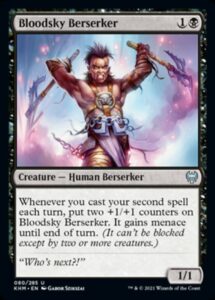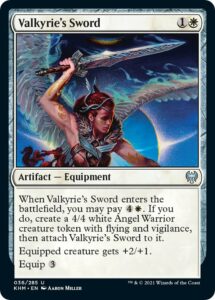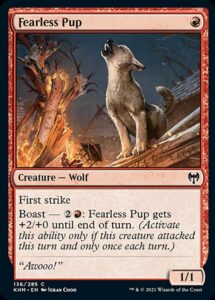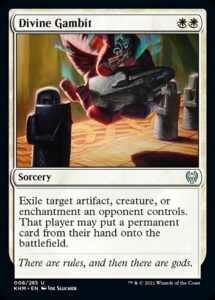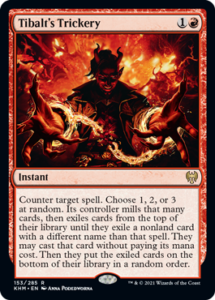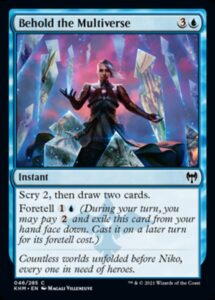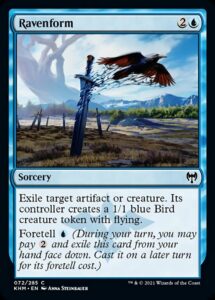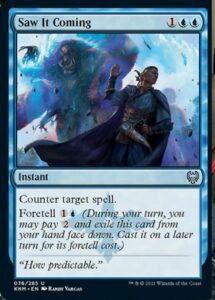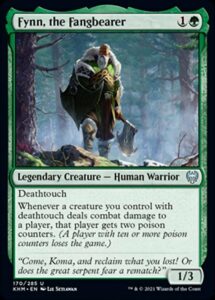Spoiler season wraps up tomorrow and prerelease begins next Thursday. With almost the complete set revealed, Kaldheim seems to be among the most complex and mechanically diverse Standard sets this side of Time Spiral block.
Last week, we delved into the set’s many mechanics—and we didn’t even get into mini-mechanics like vehicles, warriors, or ‘exile a creature card from your graveyard.’ Today, we’ll finish with a look at several of the set’s most notable designs.
Second Spell-Matters
I could have sworn this was a UR theme recently, but to the best of my recollection, it has never been a Limited theme. UR cared about drawing a second card in Throne of Eldraine and Modern Horizons and we’ve seen one-off cards like Incursion Specialist, Pyromancer’s Assault, and Thunder Drake; but WB will be pioneering this ability as a major theme. It’s definitely a change of pace for a color pair usually defined by lifegain, creature attrition, and tribal decks to do something completely different. This implementation looks like it’ll skew fairly aggressive—WB is better at filling out a curve with cheap creatures than cheap spells. As was the case with Mentor, this should do the great work of taking a normally familiar strategy (go wide) and spice it up with quests along the way.
Frankly, the only concern I have about this archetype is that it seems there is also a WB angel subtheme (which, granted, has more support at present from cards you can’t open in Draft Boosters). Looking over the set spoiler, I’m concerned that it might be trying to have color pairs double up on strategies (as they did in Zendikar Rising), but without Party’s glue unifying more the majority of color pairs.
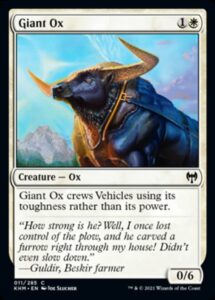 Cow Crew
Cow Crew
Giant Ox and Colossal Plow are a clear two-card combo. Experienced players may balk at such an obvious combination; but it’s important to provide players, especially new players, with more straightforward discoveries. This combination is especially resonant, since you can find it mechanically (the ox’s ability lets it exactly crew the plow alone) or thematically (it makes sense for a cow to pull a plow). There’s just the question of whether a plow feels like a vehicle—it looks more like something you’d pull than a tractor you’d drive.
Playing with Swords
Mirrodin Besieged introduced Living Weapon, a way to offset equipment’s neither being a creature nor a removal spell. Zendikar Rising introduced a different twist, where snap-on equipment provided an immediate bonus. Kaldheim introduces a marriage between the two, where you can pay extra for Living Weapon but snap it into something far superior to a Germ. This is inherently a Spike mechanic, since a skilled player knows when to leave value on the table and play out the equipment early. That said, Valkyrie’s Sword, Giant’s Amulet, Draugr’s Helm are unimpressive equipment on their own, with Dwarven Hammer seeming the standout.
Threat of Acti-AWOOO!
It’s wonderful that Magic is embracing more cuteness. Not only is this just an adorable lil’ pup, but the flavor text makes clear what this little braggart sounds like.
Mechanically, Fearless Pup follows a line of wolves that can be pumped, but instead of having Haste or Trample, its First Strike makes it a serious threat in the mid game rather than a Fireball in the late game.
Divine Confusion
Divine Gambit is perplexing. In Constructed, there is almost no situation where letting your opponent cast a one-sided Show and Tell is acceptable. White has plenty of better removal in Commander that won’t accidentally turn a player into the Archenemy. In Limited, there are no indestructible gods that need to be exiled, but at least you get the satisfaction of casting this in the late game when your opponent has nothing. Perhaps this card references an element of Norse mythology I’m unaware of (I haven’t read it since I was in grade school) or perhaps it’s a pet card that finally made it into a set. I’m not sure, and it’s not often I’m confused by both the design and mechanics of a card.
But if we’re going to talk about confusion, let’s really talk about confusion.
Tibalt Makes a Mess
There is so much to take in here. We have a red counterspell, something considered for years both a color pie break and a flavor fail (red is the least reactive color). We have red milling, something red doesn’t do (there are five red cards that self-mill and none that mill your opponent). We have a card that exemplifies the problems of Magic cards being in Magic-ese, where a dense text box seemingly interrupts itself to choose a random number. Put all of this together and you have an aggressively costed red counterspell that mills all to prevent the shuffling of Chaos Warp.
I’d wager Tibalt’s Trickery exists because the needs of Commander won out over the color pie once again. Red simply cannot be all aggro, all the time in multiplayer, so it gets red takes on previously off-color effects like card draw, ramp, and now countermagic. I appreciate that Tibalt’s Trickery does let you set up a guaranteed Emrakul, the Aeons Torn, but makes you work for it (you have to put her fourth from the top and ensure that your second and third cards are both lands). But this is one of the most awkwardly designed cards I’ve ever seen (if you exclude Magic’s first few formative years). That text box is so dense, the effect is contrary to what red does (especially in Standard), and the mill rider adds confusion and creates a time delay in an attempt to eliminate a time delay. I’m a fan of Tibalt, but I’m no fan of this card.
Omen of the See Beyond
In lighter news, I love the designs of both Behold the Multiverse and Glimpse the Cosmos. One is a twist on Glimpse of Genius, the other a unique twist on Flashback. The main issue: the names. If paper tournaments existed right now, people would probably constantly mix up the similarly named card draw spells with 1U costs.
Break, Bend, or Status Quo?
A reliable chorus of “this should be a white card” has grown much more vocal over the course of the pandemic. Ravenform is in blue’s color pie—blue can disrupt both artifacts and creatures. As with all blue Polymorph effects, it would look less weird if it were a reversible aura like Ichthyomorphosis, but that would be a messy text box, especially for a common:
Enchant creature or artifact
Enchanted permanent is a blue Bird creature with base power and toughness 1/1 and has flying, and it loses all other abilities, card types, and creature types.
Foretell U (During your turn, you may pay 2 and exile this card from your hand face down. Cast it on a later turn for its fortell cost.)
But yes, this could also be a white card. And yes, it looks weird for blue to get a card vaguely resembling Path to Exile when it’s the worst at removal (though every color needs and deservedly gets access to quality Limited interaction these days). And while blue regularly gets Malfunctions that interact with artifacts, Mark Rosewater considers Ravenform a mistake—not because it’s an aggressively costed blue exile spell with minimal downside, but because it exiles artifacts.
Ravenform makes a strong argument for both policing color pie breaks assiduously (a little break becomes precedent for bigger breaks later on) and clearly communicating color pie barriers (it seems as though every blue Polymorph is controversial).
So Annoying Yet So Good
Ugh! What a satisfying name to snarkily say to your opponent as you ruin their day. I love that you can Foretell this and pretend as though you knew exactly what spell of your opponent’s it was intended to counter. I appreciate that it has the same Foretell cost as Behold the Multiverse to wreck people in Standard. My only question is why its Foretell cost isn’t UU—hard counterspells require two colored mana (though Kaldheim is full of precedent-setting designs); but more importantly, making this card a bit weaker would let player have their Counterspell-in-Standard fantasy.
You did how much work for one card?!
I would’ve expected poison to return by or before Magic revisited the Phyrexians (which technically is happening thanks to Vorinclex, Monstrous Raider), but I never would’ve guessed it would appear on a single card. Magic Arena doesn’t currently support poison, so adding the mechanic requires adding new UI elements (and likely new sound effects and an animation, but many rares and all mythics get those). That’s a big ask for a single uncommon. Mechanically, it’s quite simple, but that seems a lot to ask of the Arena team and also yet another mechanic players need to learn for Kaldheim Limited.
Fynn, the Fangbearer (and also Vorinclex) is almost certainly a harbinger of a major poison theme. It’s fun wondering when the payoff will be—perhaps there’s an assassin program at Strixhaven or poison is employed in the summer’s D&D set. Perhaps it won’t be until 2022 but we’ll see praetors continue to invade other planes along the way. It’s a rare treat that Magic seeds an obvious (yet cryptic) clue for the future and it’ll be interesting seeing how the payoff lands.
Zachary Barash is a New York City-based game designer and the commissioner of Team Draft League. He designs for Kingdom Death: Monster, has a Game Design MFA from the NYU Game Center, and does freelance game design. When the stars align, he streams Magic (but the stars align way less often than he’d like).

